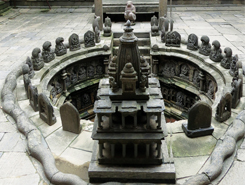IT IS IN THE LOSS OF HERITAGE THAT PEOPLE APPRECIATE THE ROLE IT PLAYS TOWARDS REBUILDING THE SPIRIT OF THE COUNTRY AND ITS CULTURE. A LOOK AT PEOPLE PARTICIPATION IN REBUILDING NEPAL’S HERITAGE SITES.
In the earthquakes that struck Nepal on April 25 and May 12, 2015, the country lost about 9000 lives and over half a million homes were destroyed. The earthquakes also affected about 2,900 heritage structures. Total estimated damages to tangible heritage came to Rs 1,074 crore ($ 160 million).
Kathmandu Valley - an unparalleled concentration of cultural heritage in the world - with seven World Heritage Sites, a large number of national monuments and an even larger number of community- and privately-owned heritage, also suffered significant damage. Some of the major monuments in Kathmandu’s seven World Heritage Zones were badly damaged and many collapsed to rubble.
The loss in revenue due to decline in ticket sales to damaged monuments within Kathmandu Valley for the first 12 months alone was estimated at about Rs 40 crore ($ 6 million).
Though the earthquakes are undoubtedly an enormous human tragedy, the loss of heritage is much more than just physical damage. Restoration work requires good documentation, authenticity, skilled workers, large amounts of traditional materials, sustained efforts and time, all of which are in short supply and as if this was not enough, funds are quite hard to come by.
In the post-earthquake scenario, already pressed governments may not have the capacity, experience or bandwidth to address the immediate needs of damaged heritage. Unattended damaged sites can see rapid deterioration and even complete destruction due to multiple factors including theft, effect of rain, snow, humidity, fires, even salvage and reuse of priceless elements for other purposes.
It’s quite heartening that in the post-earthquake scenario, it was the people of Nepal that came to the rescue of heritage sites. Kai Weise, eminent conservation architect for Nepal, in the article, “Conserving Continuity”, that appeared in Himal Southasian mentions that the spontaneous reaction by the people was linked to the Valley’s ancient Guthi system – a system of local kinship organisations that amongst other things were responsible for the maintenance and upkeep of monuments. Though this system was subsumed into the government and the community ownership of the monuments lost, the communities’ response shows that their sense of belonging and responsibility remains.
The Kathmandu Valley Preservation Trust (KVPT), working in the Valley since 1991 has been in collaboration with the Nepal Archaeological Department responsible for the protection, restoration and upkeep of over 50 monuments in the Kathmandu Valley. The UNESCO World Heritage Site of the Patan Durbar Square which was badly hit with six major monuments, including the Char Narayana, Radha Rani, Hari Shankar temples and the twin Mani Mandapas, were completely damaged.
Dr Rohit Ranjitkar, Director, KVPT, explained that the first step has been proper storage of all that could be salvaged. Some portions that were partially damaged in the earthquakes were under restoration prior to the earthquake; since complete documentation was available, they were taken up on priority and these are at an advanced stage of completion. Sundari Chowk, which is undoubtedly one of the architectural and sculptural masterpieces of the world, was under restoration when the earthquake destroyed the first floor of its eastern wing. Though authenticity has been maintained while rebuilding, like using of brick in mud mortar, seismic strengthening by use of appropriate timber members has been done.
Kathmandu’s Swayambunath, centred around the massive gleaming white hemispheric dome of the mahachaitya, the main stupa and its associated buildings, was also badly hit. The Anantapur Temple’s shikar also collapsed and the stupa was left with cracks. Like elsewhere, the community was the first responder which along with the armed forces salvaged all that could be. “It was essential to seal the cracks in the stupa as rainwater ingress would cause extensive damage; expert discussions determined a process of filling up the cracks keeping in mind the monument’s inquisitive monkeys that would have most likely removed the interventions,” says Ranjitkar.
In the case of the Kathmandu Durbar square, Alok Tuladhar, an acclaimed photographer and documentarian, engaged with heritage practices, explained how the Panch Mukhi Hanuman Temple, which is a unique structure of five circular roofs built in a concentric manner, saw the toppling over of the top stories. Again, since it was already slated for restoration and repair prior to the earthquake, there was near complete documentation and that permitted the government to undertake repair work on a priority. it was completed in May 2016 and serves as a best practice for the country. A third of the total funds required for restoration were provided by the US Ambassador’s Fund for Cultural Preservation, the remaining two-thirds was provided by the Department of Archaeology.
However, numerous other important structures like the Kashtamandap, considered to be a foundational structure of Kathmandu, that were completely razed by the earthquakes have seen virtually no work. Tuladhar, who belongs to a family of traditional traders, fondly recalled how his ancestors would spend his time at the Kasthamandap. Many Kathmandu residents have similar memories. Here again though progress has not been encouraging, it is citizen groups with the help of historians and conservation professionals that are keeping the pressure on the government and acting as watch dogs, monitoring proposals and interventions closely.
Speedy post-earthquake reconstruction is yet to take off in Nepal and heritage reconstruction unfortunately other than a few successful examples struggles from the lack of support and patronage. There clearly is a long way to go. It is in its loss that civil society, communities and experts are appreciating the foundational role heritage plays towards rebuilding the spirit of the people, of a culture and a country.

